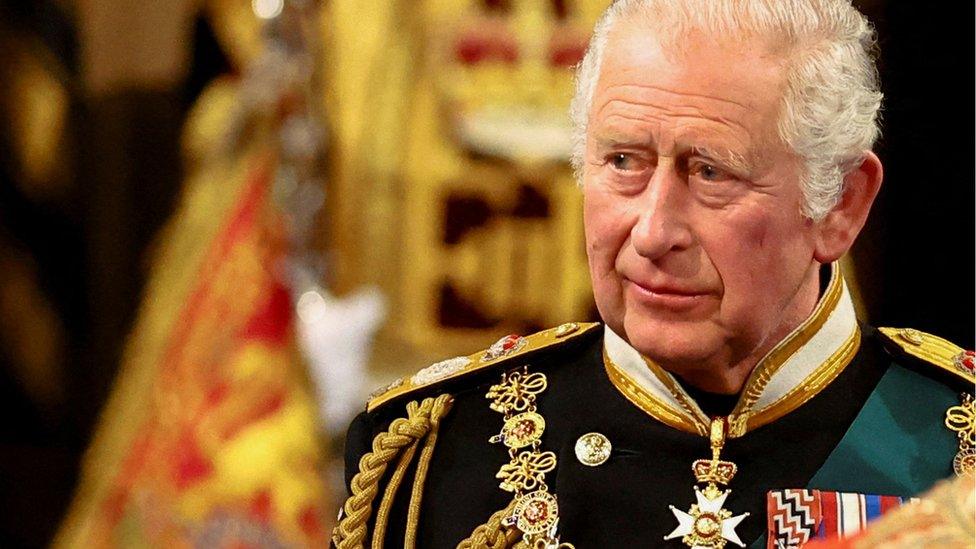Who took part in the Coronation Procession?
- Published

Thousands of people lined the streets of central London hoping to catch a glimpse of King Charles III as he travelled from Westminster Abbey to Buckingham Palace after his coronation.
Soldiers and royal footmen, marching bands and ornate coaches, magnificent horses and an Irish wolfhound called Seamus all took part in the UK military's largest ceremonial operation for 70 years - and it all ended with a short fly-past. Here's how the day unfolded.
Procession to Buckingham Palace
The service finished at 13:00 BST and the King and Queen travelled back to the palace in the ornate Gold State Coach as part of the Coronation Procession - a much larger ceremonial display than the morning's procession to the abbey.
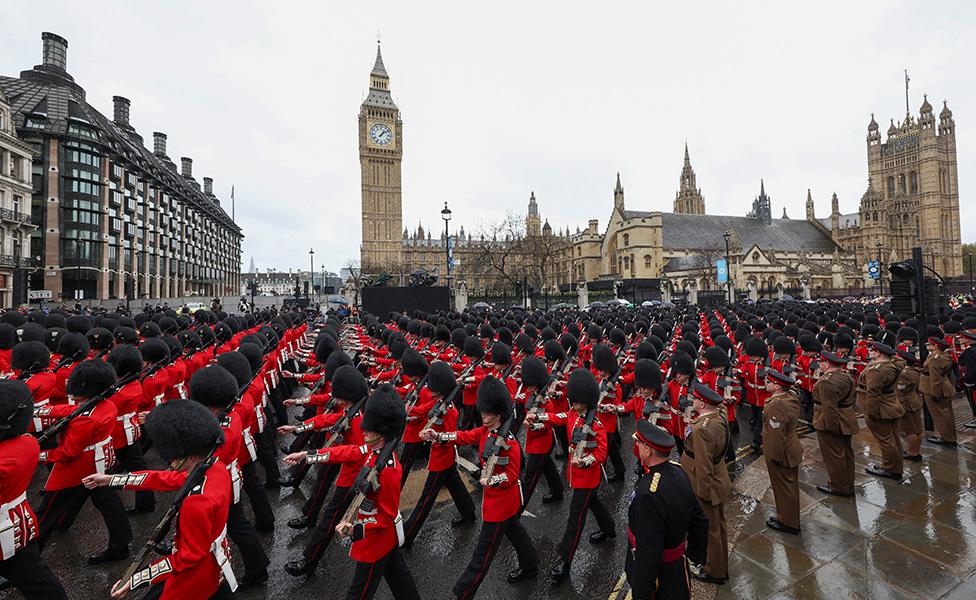
At the head of the procession - about a mile in front - was Brigade Major Lieutenant Colonel James Shaw riding Sovereign's Shadow.
He led more than 4,000 members of the armed forces from the UK and across the Commonwealth, 19 bands and flag-bearers, formed into eight groups. A full list of all those who took is at the end of this page.

The 1.42-mile route was lined by 1,000 members of the military from the Army, Royal Navy and Royal Air Force.
The Gold State Coach
The Gold State Coach, which is covered in gold leaf and carved decorations, was first used by King George III to travel to the State Opening of Parliament in 1762. The first king to use the coach in a coronation was William IV in 1831 and it has been used at every coronation since.
The panels feature Roman gods, and sculptures of cherubs and tritons ride on the roof and over the wheels.
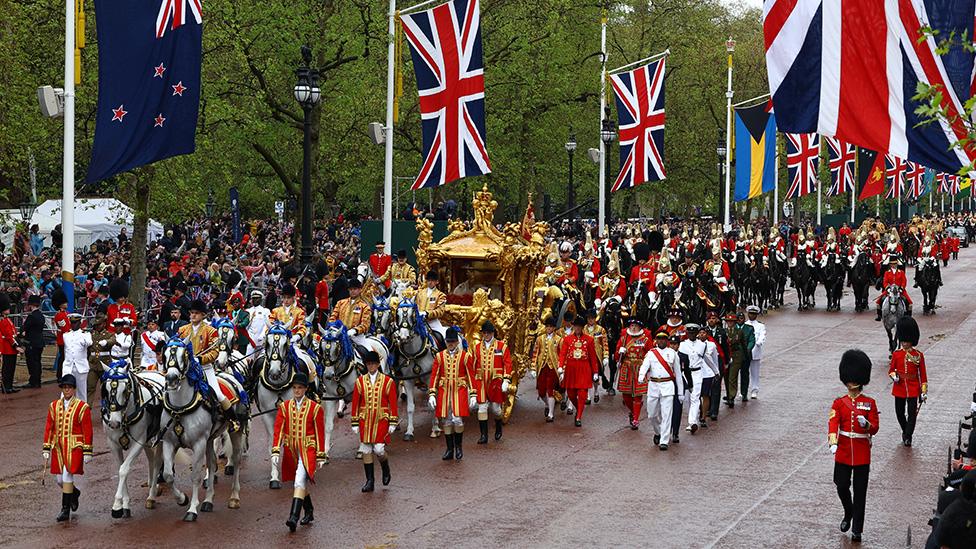
Queen Elizabeth II, who used the coach for her coronation as well as jubilee celebrations, said it might look luxurious but it was a horrible, uncomfortable ride because of the lack of suspension.
It weighs four tonnes and is pulled at walking pace by eight grey horses, with a mounted rider or postilion for each pair.
Alongside the coach, walked eight grooms, six footmen and four Yeomen of the Guard.
Also present were members of the Royal Watermen, who traditionally rowed the Royal Barges up and down the River Thames between the royal palaces, but now have ceremonial duties.
The Princess Royal was among those riding behind the coach, in her role as Gold Stick and Colonel The Blues and Royals - a ceremonial bodyguard entrusted with the safety of the sovereign.
The Prince and Princess of Wales and their three children, Prince George, Princess Charlotte and Prince Louis, were in the first carriage behind the coach with other "working royals" - those family members who carry out official duties on behalf of the King - in carriages and cars following them.

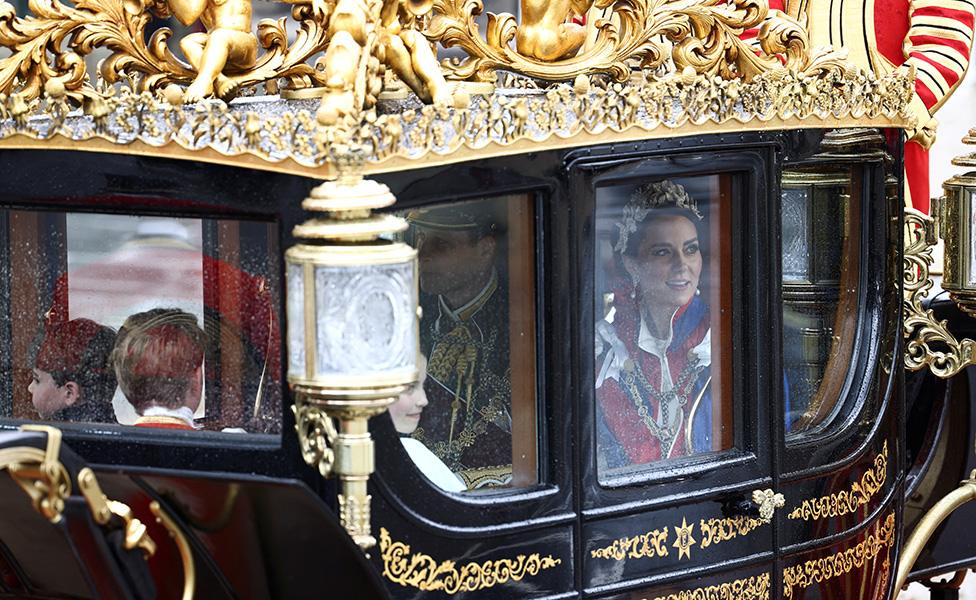
The marching bands kept beat of 108 paces a minute, which is slightly slower than a standard quick march of 116 paces a minute, because of the speed of the heavy coach.
Members of the RAF were in group three of the procession, the Army in the next three groups - with the Royal Lancers in group four - and the Royal Navy and Royal Marines in group seven.

The Irish Guards with their mascot Seamus, the Irish wolfhound, were part of the final group ahead of the coach, which also includes the Welsh Guards and Scots Guards.
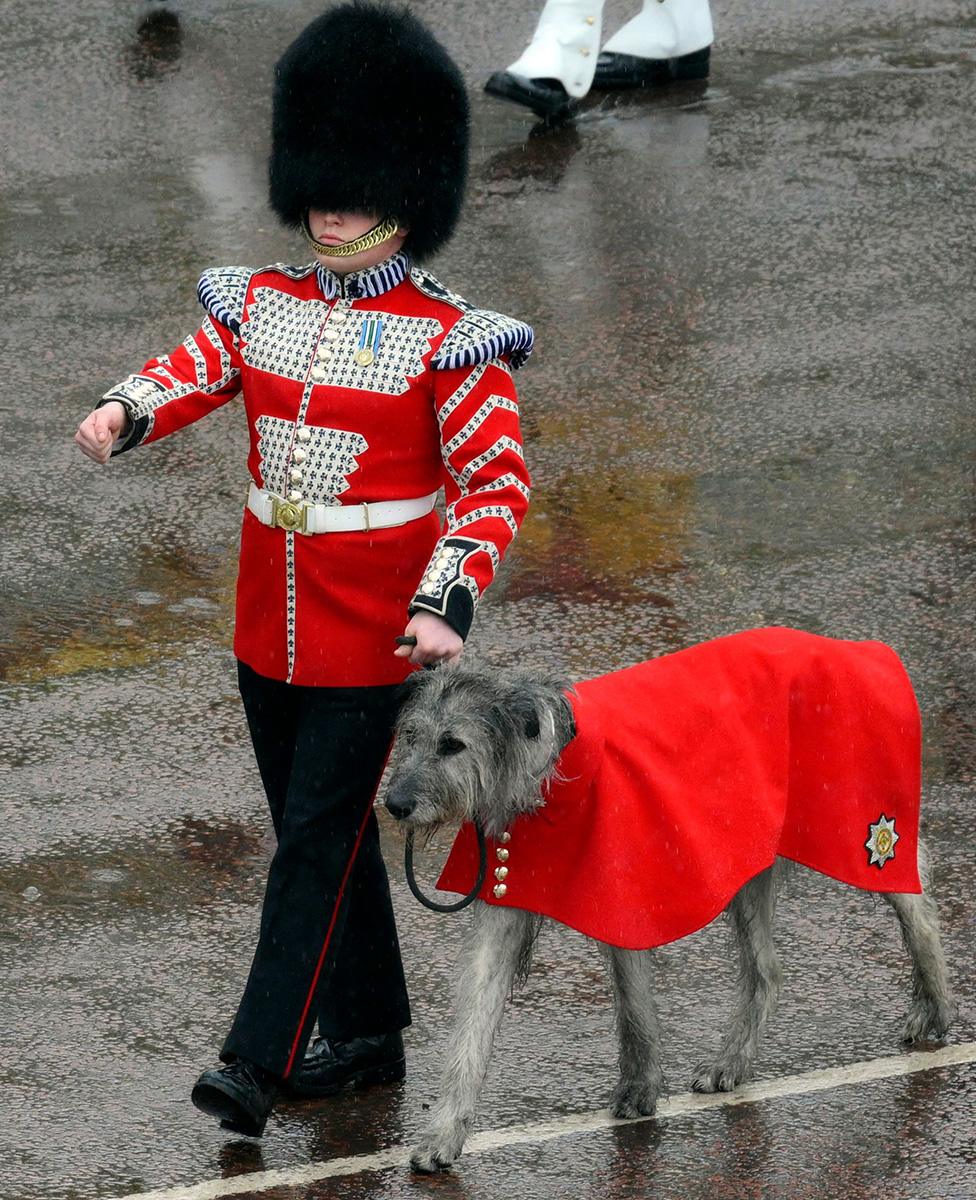
The Ministry of Defence said it was the largest military procession in London since more than 16,000 people took part in Queen Elizabeth II's coronation procession in 1953.


The coach made the 1.42 mile journey in about 30 minutes.
Once the procession had passed, members of the public were allowed to move up The Mall to fill the area around the Queen Victoria Memorial in front of Buckingham Palace.
Royal Salute and three cheers
In a coronation first, all those marching formed up in the palace gardens to give a Royal Salute and three cheers to the King and Queen.
The King and other members of the Royal Family then proceeded to the front balcony of Buckingham Palace to greet the public crowds assembled in The Mall.
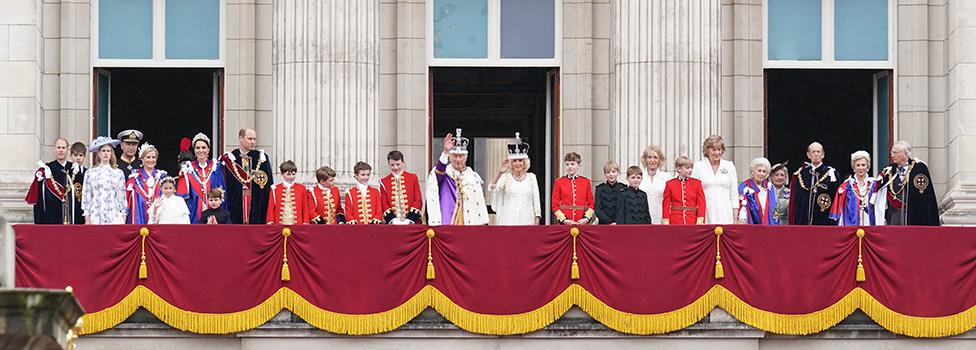

Palace fly-past
The balcony moment was due to be accompanied by a spectacular six-minute fly-past involving more than 60 aircraft from the Army, Royal Navy and Royal Air Force.
But due to poor weather it was scaled back to helicopters and the Red Arrows display team.
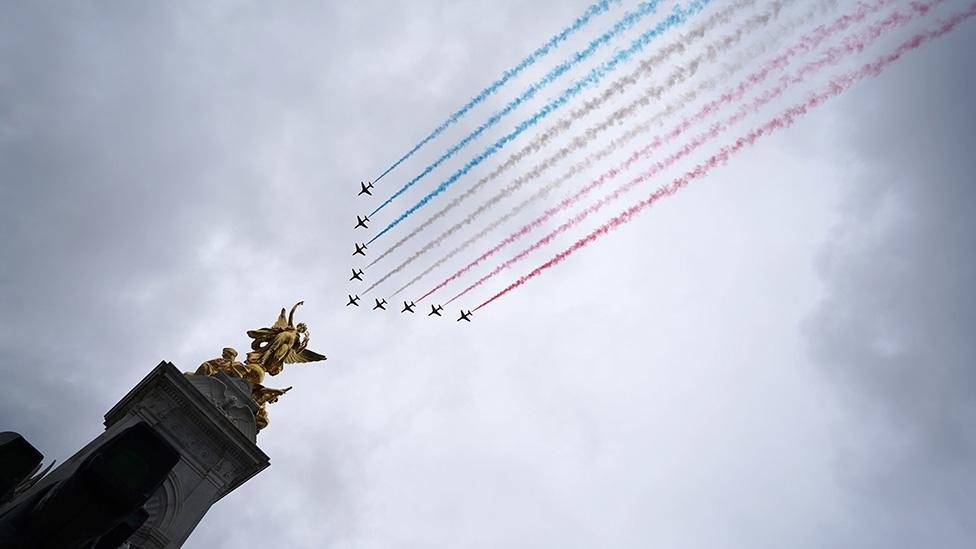

The Coronation Procession in full

Mounted Household Troops: Brigade Major's Retinue • Mounted Band of the Household Cavalry • The King's Troop Royal Horse Artillery

Representatives from the Commonwealth nations: Band of the Royal Regiment of Scotland • Highland Band of the Royal Regiment of Scotland • Lowland Band of the Royal Regiment of Scotland • Representative Detachments of Realm and Commonwealth Forces: Antigua and Barbuda, Australia, Bahamas, Bangladesh, Barbados, Belize, Brunei Darussalam, Canada, Cameroon, Eswatini, Fiji, Gabon, Jamaica, Kenya, Lesotho, Malawi, Malaysia, Maldives, Malta, New Zealand, Pakistan, Papua New Guinea, Rwanda, St Kitts and Nevis, Seychelles, Sierra Leone, Sri Lanka, Tanzania, Togo, Tonga, Trinidad and Tobago, Uganda, Zambia
Representative Detachments of British Overseas Territories: Falkland Islands Defence Force, Cayman Islands Regiment, Turks and Caicos Regiment, Royal Montserrat Defence Force

Representatives from Royal Air Force: Royal Air Force Regiment • Bands of the Royal Air Force • Royal Air Force Halton • Royal Auxiliary Air Force • Royal Air Force Cranwell

Representatives from the Army:
Army Royal Armoured Corps: Head of Arms and Services • Colonel Royal Armoured Corps • The Royal Scots Dragoon Guards (Carabineers and Greys) • 1st The Queen's Dragoon Guards • The Queen's Royal Hussars (The Queen's Own and Royal Irish) • The Royal Dragoon Guards • British Army Bands Colchester and Sandhurst • The King's Royal Hussars • The Royal Lancers (Queen Elizabeths' Own) • Royal Tank Regiment • The Light Dragoons • The Royal Wessex Yeomanry • The Royal Yeomanry • Scottish and Northern Irish Yeomanry • The Queen's Royal Yeomanry • Corps Sergeant Major, Royal Armoured Corps
Army Corps and Infantry: Corps Colonels of the Royal Regiment of Artillery, Royal Corps of Engineers, Royal Corps of Signals, Infantry • Royal Corps of Engineers • Royal Regiment of Artillery • Royal Regiment of Scotland • Royal Corps of Signals • Duke of Lancaster's Regiment • Princess of Wales's Royal Regiment • Royal Anglian Regiment • Royal Regiment of Fusiliers • Bands of the Rifles and Brigade of Gurkhas • Mercian Regiment • Royal Yorkshire Regiment • Royal Irish Regiment • Royal Welsh • Royal Gurkha Rifles • Parachute Regiment • Rangers • The Rifles • Corps Sergeant Majors of the Royal Regiment of Artillery, Corps of Royal Engineers, Royal Corps of Signals, Infantry
Army Corps: Corps Colonels of the Army Air Corps, Royal Army Medical Corps, Royal Logistics Corps, Adjutant General's Corps, Royal Electrical and Mechanical Engineers, Intelligence Corps • Army Air Corps • Royal Army Medical Corps • Royal Logistic Corps • Adjutant General's Corps • Royal Electrical and Mechanical Engineers • Royal Army Veterinary Corps • British Army Bands Catterick and Tidworth • Royal Army Dental Corps • Small Arms Service Corps • Royal Army Physical Training Corps • Intelligence Corps • Royal Military Academy, Sandhurst • Queen Alexandra's Royal Army Nursing Corps • Royal Army Physical Training Corps • Corps Sergeant Majors of the Army Air Corps, Royal Army Medical Corps, Royal Logistics Corps, Adjutant General's Corps, Royal Electrical and Mechanical Engineers, Intelligence Corps • Royal Army Chaplain's Department • Honourable Artillery Company • Royal Bermuda Regiment • Royal Gibraltar Regiment

Representatives from the Royal Navy and Royal Marines: Royal Navy • Royal Navy Reserve • Bands of the Royal Marines • Royal Marines • Royal Marines Reserve • Commando Training Centre Royal Marines and Britannia Royal Naval College • Service Chiefs: Commander Strategic Command • Vice Chief of the Defence Staff • Chief of the Air Staff, Chief of the General Staff • Chief of the Naval Staff • Chief of the Defence Staff • Command Warrant Officer Strategic Command • Corps Sergeant Major Royal Marines • Warrant Officer to the Royal Air Force • Army Sergeant Major • Warrant Officer to the Royal Navy • Senior Enlisted Adviser to the Chiefs of Staff Committee

Representatives from the Household divisions:
Massed Foot Guards' Bands: Coldstream Guards • Irish Guards • Welsh Guards • Scots Guards • Grenadier Guards
Foot Guards: Regimental Lieutenant Colonel Coldstream Guards • Regimental Lieutenant Colonel Irish Guards • Regimental Lieutenant Colonel London Guards • Regimental Lieutenant Colonel Welsh Guards • Regimental Lieutenant Colonel Scots Guards • Regimental Lieutenant Colonel Grenadier Guards • Commanding Officer Coldstream Guards • Commanding Officer Irish Guards • Commanding Officer London Guards • Commanding Officer Welsh Guards • Commanding Officer Scots Guards • Commanding Officer Grenadier Guards • The King's Colour Coldstream Guards • The King's Colour Irish Guards • The King's Colour Welsh Guards • The King's Colour Scots Guards • The King's Colour Grenadier Guards • Coldstream Guards • Irish Guards • Welsh Guards • Scots Guards • Grenadier Guards • Regimental Sergeant Major Coldstream Guards • Regimental Sergeant Major Irish Guards • Regimental Sergeant Major London Guards • Regimental Sergeant Major Welsh Guards • Regimental Sergeant Major Scots Guards • Regimental Sergeant Major Grenadier Guards
Household Cavalry Regiment (Dismounted): Commanding Officer Household Cavalry Regiment • The Blues and Royals (Royal Horse Guards and 1st Dragoons) • The Life Guards • Regimental Corporal Major Household Cavalry Regiment • King's Gurkha Orderly Officer (x2)
The King's Body Guards and Royal Watermen: The King's Bargemaster • Officer (x4) • Chief Yeoman Warder with Mace • Colour (x2) • Standard • Yeomen Warders of HM Fortress the Tower of London (x12) • Royal Watermen (x12) • The King's Bodyguard the Yeomen of the Guard (x12) • The King's Bodyguard for Scotland, the Royal Company of Archers (x12) • His Majesty's Body Guard of the Honourable Corps of Gentlemen at Arms (x12) • Yeoman Gaoler with Axe • Messenger Sergeant Major • Officer (x2) • Royal Canadian Mounted Police • Staff Captain Headquarters Household Division • Major General Commanding the Household Division • ADC to the Major General Commanding the Household Division

Led by: 1st Division of The Sovereign's Escort • 2nd Division of The Sovereign's Escort
Drawn by: Eight Grey Horses
Carrying: His Majesty the King, Her Majesty the Queen
Flanked by: Representatives of the Realm Armed Forces • Royal Waterman (x4) • Grooms (x8) • Palace Footmen (x6) • Yeoman of the Guard (x4) • Brakeman • Escort Commander • Field Officer of the Escort • Standard Coverer • Sovereign's Standard of The Life Guards • Trumpeter • The Princess Royal, Gold Stick and Colonel The Blues and Royals (Royal Horse Guards and 1st Dragoons) • Colonel Coldstream Guards • Master of the Horse • Gold Stick in Waiting and Colonel The Life Guards • Silver Stick Adjutant • Field Officer in Brigade Waiting • Silver Stick • Crown Equerry • 3rd Division of The Sovereign's Escort

Royal Family members:
Carriage: of The Prince and Princess of Wales, Prince George of Wales, Princess Charlotte of Wales, Prince Louis of Wales
Carriage: The Duke and Duchess of Edinburgh, The Lady Louise Mountbatten Windsor, Earl of Wessex
Carriage: The Duke and Duchess of Gloucester, Vice Admiral Sir Tim Laurence
State Car: The Duke of Kent and Princess Alexandra
Followed by: 4th Division of The Sovereign's Escort
Written and produced by Dominic Bailey and Chris Clayton, design by Lilly Huynh and Zoe Bartholomew, illustration by Jenny Law.

Read the latest from our royal correspondent Sean Coughlan - sign up here.
- Published6 May 2023
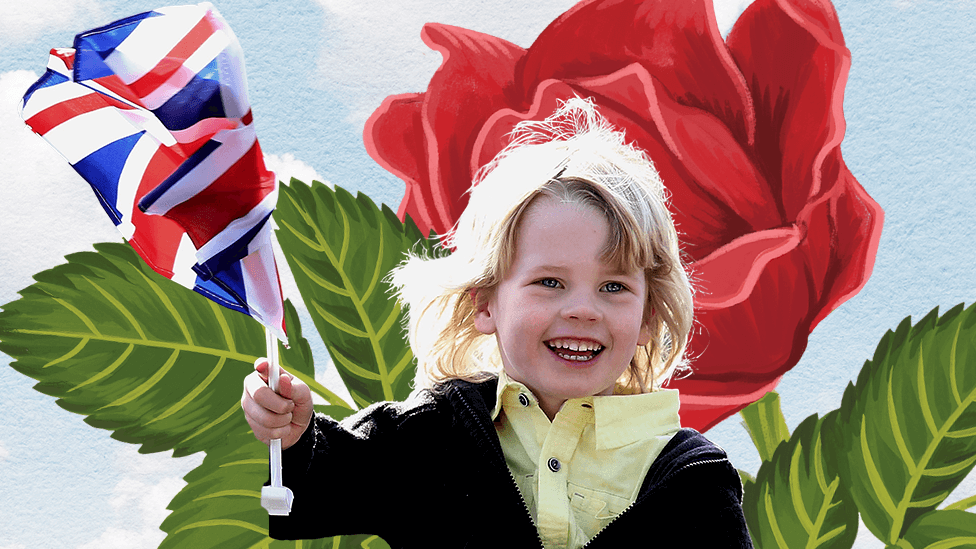
- Published24 April 2023
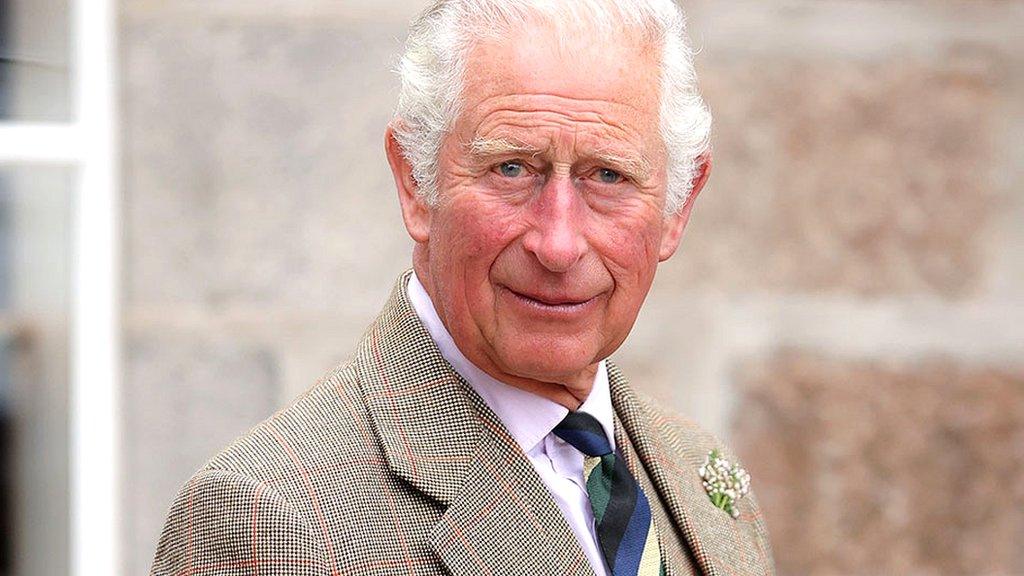
- Published6 May 2023
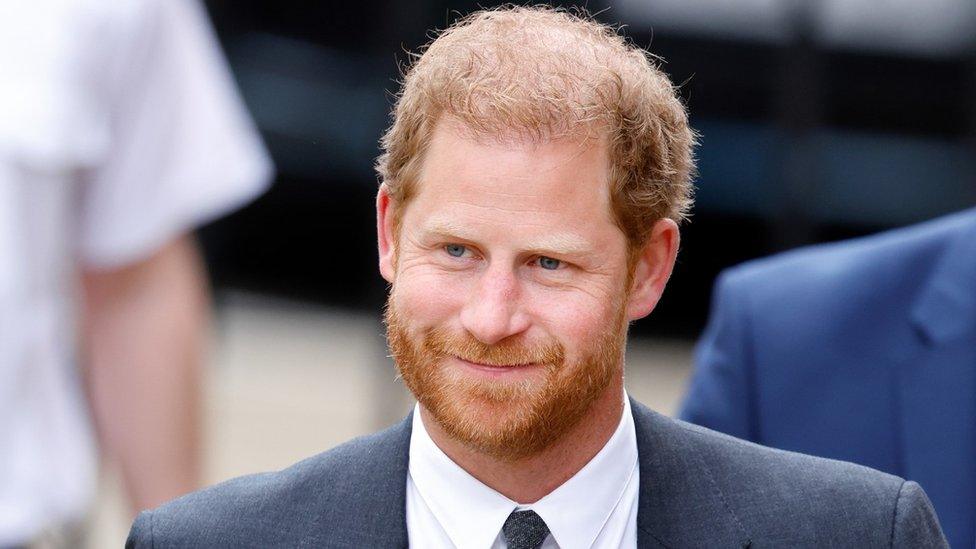
- Published19 April 2023
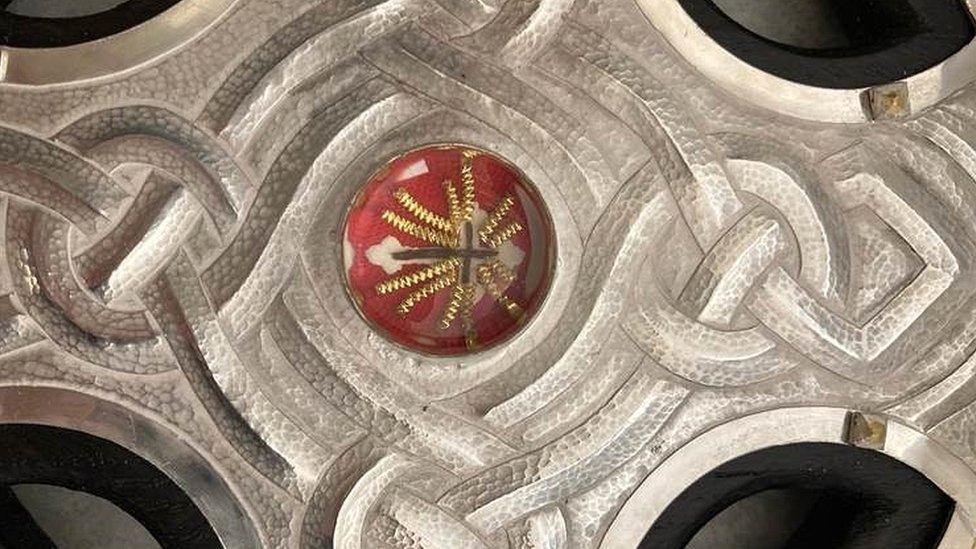
- Published18 April 2023
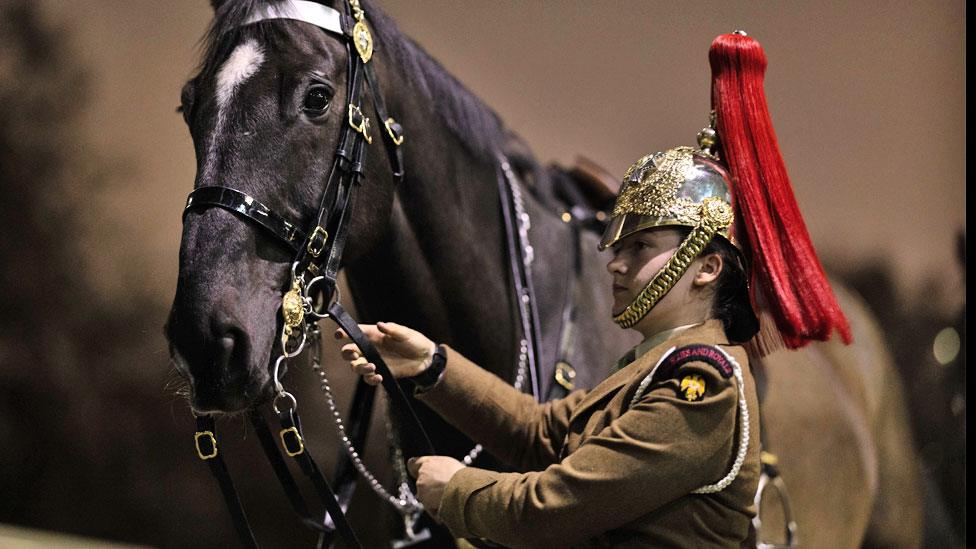
- Published20 April 2023
